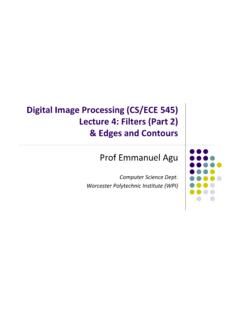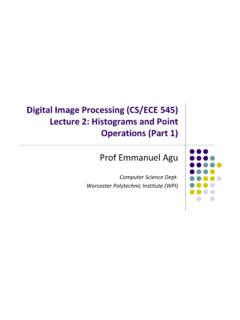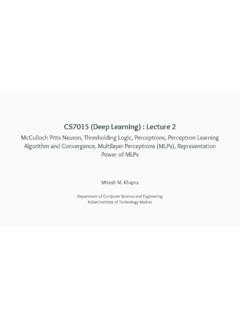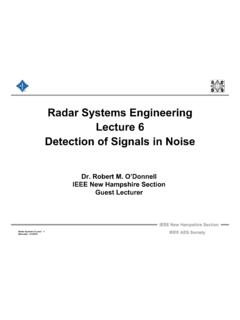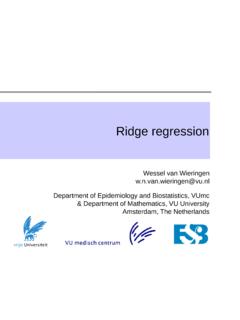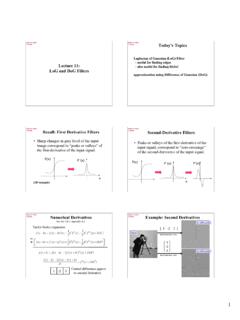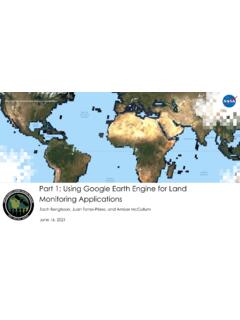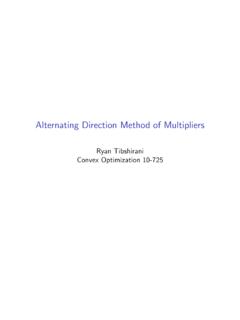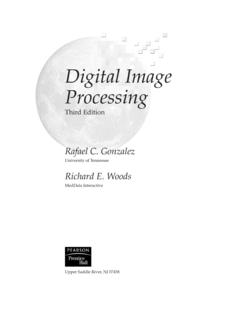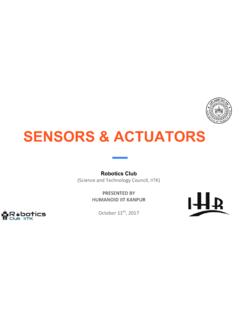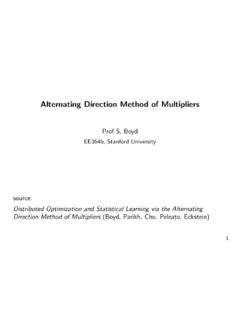Transcription of Digital Image Processing (CS/ECE 545) Histograms and …
1 Digital Image Processing (CS/ECE 545) lecture 2: Histograms and Point Operations (Part 1)Prof Emmanuel AguComputer Science Polytechnic Institute (WPI) Histograms Histograms plots how many times (frequency) each intensity value in Image occurs Example: Image (left) has 256 distinct gray levels (8 bits) Histogram (right) shows frequency (how many times) each gray level occurs Histograms Many cameras display real time Histograms of scene Helps avoid taking over exposed pictures Also easier to detect types of Processing previously applied to imageHistograms K = 16, 10 pixels have intensity value = 2 Histograms : only statistical information No indication of location of pixelsIntensity valuesHistograms Different images can have same histogram 3 images below have same histogram Half of pixels are gray, half are white Same histogram = same statisics Distribution of intensities could be different Can we reconstruct Image from histogram? No! Histograms So, a histogram for a grayscale Image with intensity values in rangewould contain exactly K entries 8 bit grayscale Image , K = 28= 256 Each histogram entry is defined as:h(i) = number of pixels with intensity I for all 0 < i< K.
2 : h(255) = number of pixels with intensity = 255 Formal definitionNumber (size of set) of pixelssuch thatInterpreting Histograms Log scale makes low values more visibleDifference between darkest and lightestHistograms Histograms help detect Image acquisition issues Problems with Image can be identified on histogram Over and under exposure Brightness Contrast Dynamic Range Point operations can be used to alter histogram. Addition Multiplication Exp and Log Intensity Windowing (Contrast Modification) Image Brightness Brightness of a grayscale Image is the averageintensityof all pixels in image1. Sum up all pixel intensities2. Divide by total number of pixelsDetecting Bad Exposure using HistogramsUnderexposedOverexposedProperl yExposedExposure? Are intensity values spread (good) out or bunched up (bad)HistogramImageImage Contrast The contrast of a grayscale Image indicates how easily objects in the Image can be distinguished High contrast Image :many distinct intensity values Low contrast: Image uses few intensity valuesHistograms and ContrastLow contrastHigh contrastNormal contrastGood Contrast?
3 Widely spread intensity values + large difference between min and max intensity values HistogramImageContrast Equation? Many different equations for contrast exist Examples: Michalson s equation for contrastContrast Equation? These equations work well for simple images with 2 luminances ( uniform foreground and background) Does not work well for complex scenes with many luminances or if min and max intensities are smallHistograms and Dynamic Range Dynamic Range: Number of distinct pixels in Image Difficult to increase Image dynamic range ( interpolation) HDR (12 14 bits) capture typical, then down sample High Dynamic RangeExtremely lowDynamic Range(6 intensity values)Low Dynamic Range(64 intensities)High Dynamic Range Imaging High dynamic range means very bright and very dark parts in a single Image (many distinct values) Dynamic range in photographed scene may exceed number of available bits to represent pixels Solution: Capture multiple images at different exposures Combine them using Image processingDetecting Image Defects using Histograms No best histogram shape, depends on application Image defects Saturation.
4 Scene illumination values outside the sensor s range are set to its min or max values => results in spike at ends of histogram Spikes and Gaps in manipulated images (not original). Why? Image Defects: Effect of Image Compression Histograms show impact of Image compression Example: in GIF compression, dynamic range is reduced to only few intensities (quantization)OriginalImageOriginalHisto gramHistogram after GIF conversionFix? Scaling Image by 50% and Interpolating values recreates some lost colorsBut GIF artifacts still visibleEffect of Image Compression Example: Effect of JPEG compression on line graphics JPEG compression designed for color imagesOriginal histogram has only 2 intensities (gray and white)JPEG Image appears dirty, fuzzy and blurredIts Histogram contains gray values not in originalComputing HistogramsReceives 8-bit Image ,Will not change itCreate array to store histogram computedGet width and height of imageIterate through Image pixels, add each intensity to appropriate histogram binImageJ Histogram Function ImageJ has a histogram function ( getHistogram( )) Prior program can be simplified if we use itReturns histogram as an array of integers Large Histograms : Binning High resolution Image can yield very large histogram Example: 32 bit Image = 232= 4,294,967,296 columns Such a large histogram impractical to display Solution?
5 Binning! Combine ranges of intensity values into histogram columnsNumber (size of set) of pixelssuch thatPixel s intensity is between aiand ai+1 Calculating Bin Size Typically use equal sized bins Bin size? Example: To create 256 bins from 14 bit imageBinned Histogram Create array to store histogram computedCalculate which bin to add pixel s intensity Increment corresponding histogramColor Image HistogramsTwo histogram: Convert color Image to gray scale Display histogram of gray Color Channel Histograms : 3 Histograms (R,G,B)Color Image Histograms Both types of Histograms provide useful information about lighting, contrast, dynamic range and saturation effects No information about the actual color distribution! Images with totally different RGB colors can have same R, G and B Histograms Solution to this ambiguity is the Combined Color Histogram. More on this laterCumulative Histogram Useful for certain operations ( histogram equalization) later Analogous to the Cumulative Density Function (CDF) Definition: Recursive definition Monotonically increasingLast entry of Cum.
6 HistogramTotal number ofpixels in imagePoint Operations Point operations changes a pixel s intensity value according to some function (don t care about pixel s neighbor) Also called a homogeneous operation New pixel intensity depends on Pixel s previous intensity I(u,v) Mapping function f( ) Does not depend on Pixel s location (u,v) Intensities of neighboring pixelsSome Homogeneous Point Operations Addition (Changes brightness) Multiplication (Stretches/shrinks Image contrast range) Real valued functions Quantizing pixel values Global thresholding Gamma correctionPoint Operation Pseudocode Input: Image with pixel intensities I(u,v) defined on [1 .. w] x [1 .. H] Output: Image with pixel intensities I (u,v) for v = 1 .. hfor u = 1 .. wset I(u, v) = f (I(u,v))Non Homogeneous Point Operation New pixel value depends on: Old value + pixel s location (u,v)Clamping Deals with pixel values outside displayable range If (a > 255) a = 255; If (a < 0) a = 0.
7 Function below will clamp (force) all values to fall within range [a,b]Example: Modify Intensity and Clamp Point operation: increase Image contrast by 50% then clamp values above 255 Increase contrastby 50%Inverting Images 2 intensity by constant ( amax)to put result in range [0,amax] Implemented as ImageJ method invert( )OriginalInverted ImageImage Negatives (Inverted Images) Image negatives useful for enhancing white or grey detail embedded in dark regions of an Image Note how much clearer the tissue is in the negative Image of the mammogram belows = - rOriginal ImageNegative ImageImages taken from Gonzalez & Woods, Digital Image Processing (2002) thresholding Implemented as imageJ method threshold( ) thresholding ExampleThresholding and Histograms Example with ath= 128 thresholding splits histogram, merges halves into a0a1 Basic Grey Level Transformations 3 most common gray level transformation: Linear Negative/Identity Logarithmic Log/Inverse log Power law nthpower/nthrootImages taken from Gonzalez & Woods, Digital Image Processing (2002)Logarithmic Transformations Maps narrow range of input levels => wider range of output values Inverse log transformation does opposite transformation The general form of the log transformation is s = c * log(1 + r) Log transformation of Fourier transform shows more details = log(1 + r)Old pixel valueNew pixel valuePower Law Transformations Power law transformations have the forms = c * r Map narrow range ofdark input values intowider range of outputvalues or vice versa Varying gives a whole family of curvesImages taken from Gonzalez & Woods, Digital Image Processing (2002)Old pixel valueNew pixel valueConstantPowerPower Law Example Magnetic Resonance (MR)
8 Image of fractured human spine Different power values highlight different detailss = r = r taken from Gonzalez & Woods, Digital Image Processing (2002)OriginalIntensity Windowing A clamp operation, then linearly stretching Image intensities to fill possible range To window an Image in [a,b] with max intensity MIntensity Windowing ExampleContrasts easier to seePoint Operations and Histograms Effect of some point operations easier to observe on Histograms Increasing brightness Raising contrast Inverting Image Point operations only shift, merge histogram entries Operations that merge histogram bins are irreversibleCombining histogram operation easier to observe on histogram Automatic Contrast Adjustment If amin= 0 and amax= 255 Original intensity rangeNew intensity rangeEffects of Automatic Contrast AdjustmentOriginalResult of automaticContrast AdjustmentLinearly stretching range causes gaps in histogramModified Contrast Adjustment Histogram Equalization Adjust 2 different images to make their Histograms (intensity distributions)
9 Similar Apply a point operation that changes histogram of modified Image into uniform distributionHistogramCumulative HistogramHistogram EqualizationSpreading out the frequencies in an Image (or equalizing the Image ) is a simple way to improve dark or washed out imagesCan be expressed as a transformation of histogram rk: input intensity sk: processed intensity k: the intensity range ( ))(kkrTs input intensityprocessed intensityIntensity range ( 0 255)Equalization Transformation FunctionImages taken from Gonzalez & Woods, Digital Image Processing (2002)Equalization Transformation FunctionsDifferent equalization function (1 4) may be usedImages taken from Gonzalez & Woods, Digital Image Processing (2002)Equalization ExamplesImages taken from Gonzalez & Woods, Digital Image Processing (2002)1 Equalization ExamplesImages taken from Gonzalez & Woods, Digital Image Processing (2002)2 Equalization ExamplesImages taken from Gonzalez & Woods, Digital Image Processing (2002)34 References Wilhelm Burger and Mark J.
10 Burge, Digital Image Processing , Springer, 2008 Histograms (Ch 4) Point operations (Ch 5) University of Utah, CS 4640: Image Processing Basics, Spring 2012 Rutgers University, CS 334, Introduction to Imaging and Multimedia, Fall 2012 Gonzales and Woods, Digital Image Processing (3rdedition), Prentice Hall
